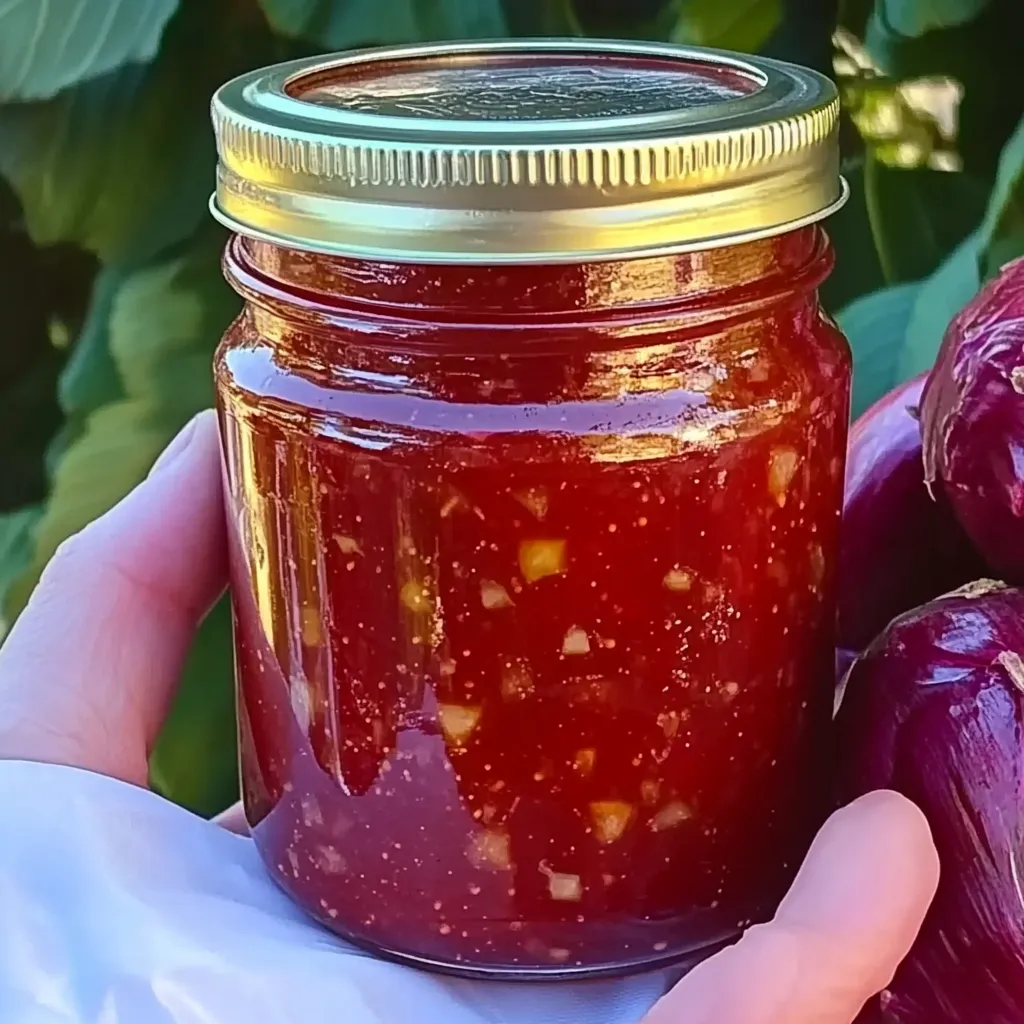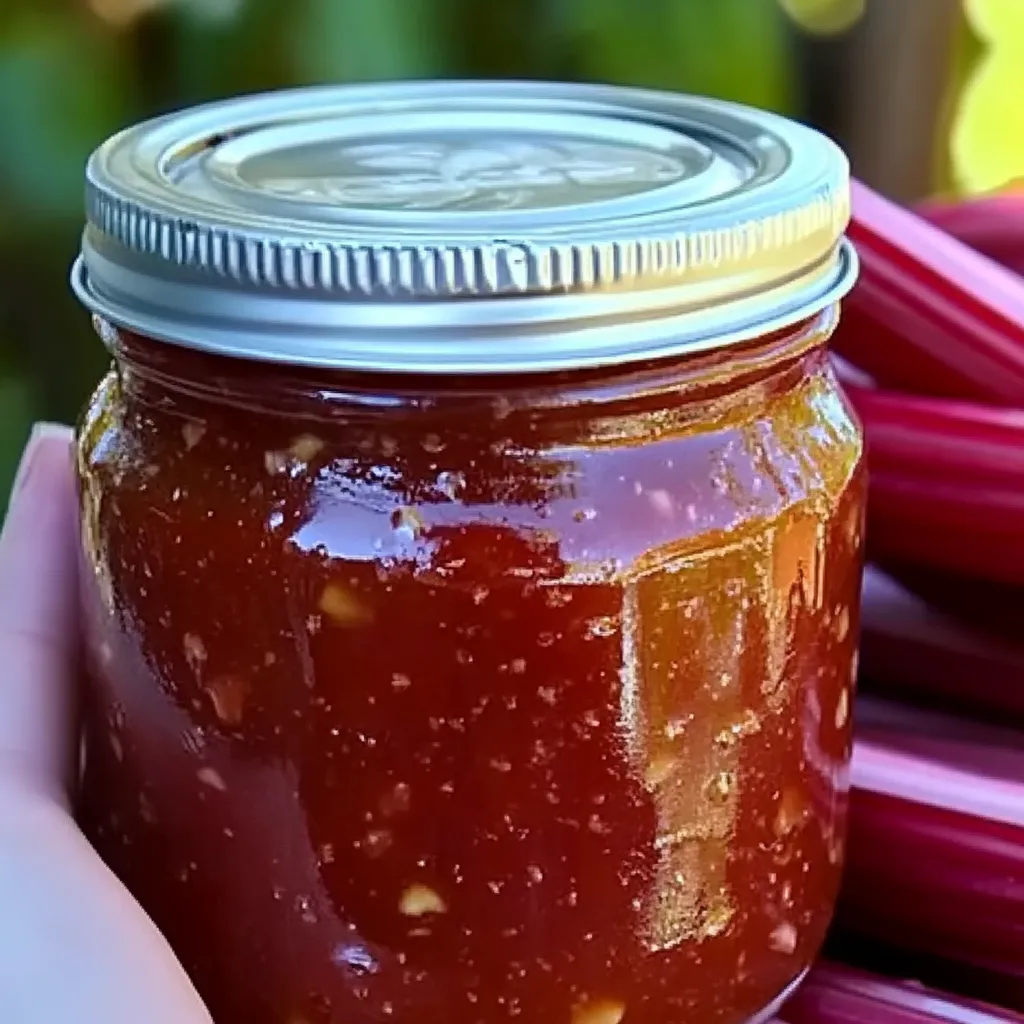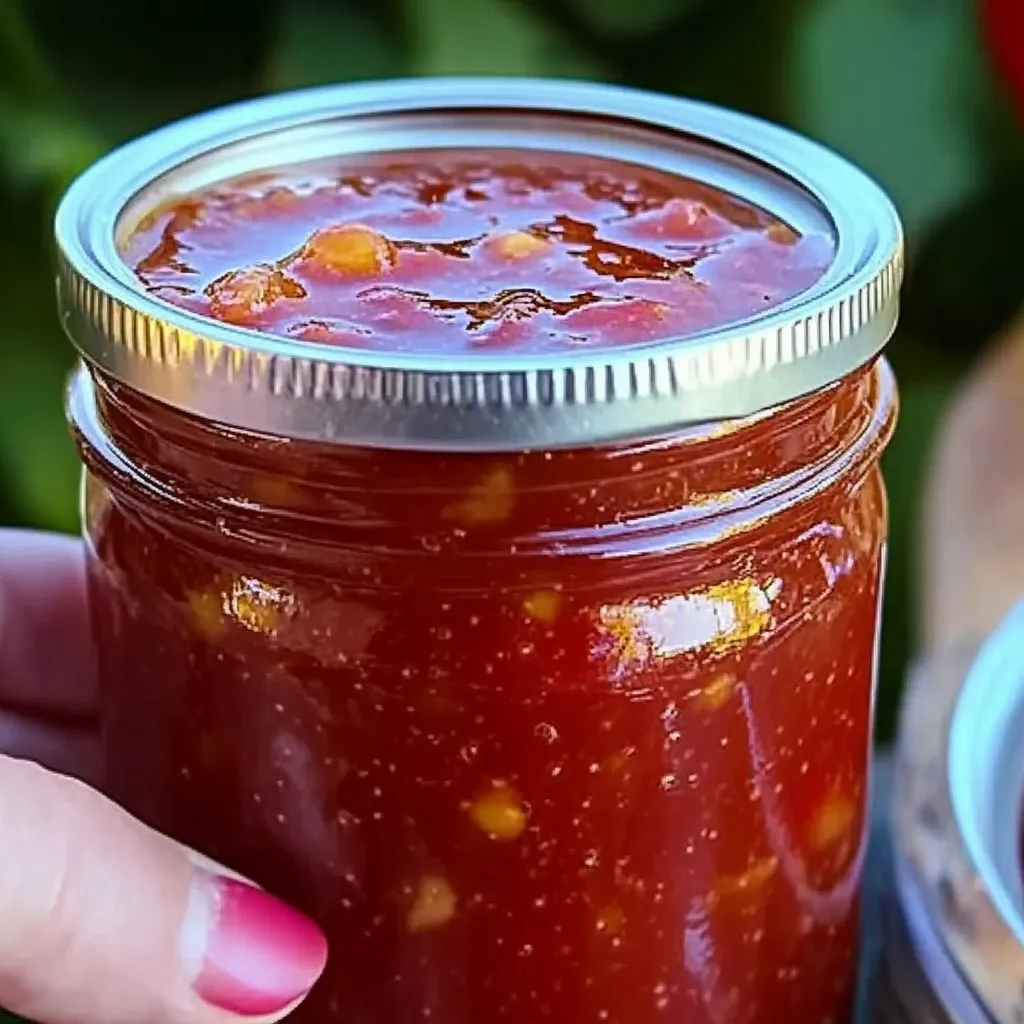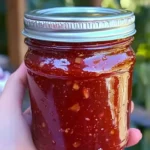I. Introduction
Rhubarb jam is a classic homemade preserve that brings out the best of this unique spring vegetable. Known for its tart flavor and striking red-green stalks, rhubarb is often mistaken for a fruit due to its common use in desserts and sweet dishes. It’s a beloved ingredient in pies, crisps, sauces, and of course, jams.
Making rhubarb jam at home is a wonderful way to capture the freshness of the season and enjoy it year-round. This sweet-tart spread is not only delicious but also surprisingly simple to prepare. It can be enjoyed on toast, swirled into yogurt, or used as a filling in baked goods. According to Leite’s Culinaria, rhubarb pairs beautifully with strawberries or vanilla for an extra flavor punch.
In this article, you’ll discover everything you need to know—from rhubarb’s history and health benefits to step-by-step instructions on making and preserving your own jam.
II. History and Origin of Rhubarb Jam
The history of rhubarb stretches back thousands of years. Originally grown in Asia for its medicinal properties, rhubarb was introduced to Europe in the 14th century and eventually made its way to North America by the 1800s. Early settlers appreciated its easy cultivation and unique tartness, quickly incorporating it into local cuisine.
Rhubarb jam gained popularity as a seasonal treat and preserving method during a time when refrigeration was not available. People would cook down rhubarb with sugar to create a long-lasting, sweet preserve. Over time, recipes evolved, often combining rhubarb with strawberries to balance the tartness. This duo became one of the most iconic jam combinations.
Today, rhubarb jam is appreciated not just for its taste but for its connection to homemade traditions and seasonal cooking. It’s often featured in cookbooks and websites that promote homemade food as both comforting and sustainable, a sentiment echoed by sites like Leite’s Culinaria, where rustic, flavorful recipes are always in style.
III. Understanding Rhubarb
To make the perfect rhubarb jam, it’s important to understand the plant itself. Botanically, rhubarb is a perennial vegetable, though it’s often treated like a fruit in culinary applications. Only the stalks are edible—rhubarb leaves are toxic and should always be discarded. The stalks range in color from pale green to deep red, depending on the variety, and the deeper the red, the sweeter the flavor tends to be.
There are several varieties of rhubarb commonly used for cooking:
- Victoria: Light red-green stalks, mild and great for jam.
- Crimson Red: Deep red stalks, sweeter flavor.
- Canadian Red: Short, thick stalks with intense color.
Nutritionally, rhubarb is low in calories and high in fiber. It’s a good source of vitamin K, calcium, and antioxidants, making it a beneficial addition to your diet. Incorporating rhubarb into jams and desserts not only enhances flavor but adds nutritional value too. As Allrecipes explains, rhubarb is often undervalued, yet it’s an excellent ingredient for creative cooks who love seasonal produce.
Rhubarb is typically in season from April to June, depending on the climate. In cooler regions, a second harvest might be possible later in the summer. It’s best to use freshly picked stalks for jam-making, as the texture and flavor are at their peak. When you spot rhubarb at the market or in your garden, it’s the perfect sign that jam season has arrived.

IV. Ingredients and Equipment Needed
To make rhubarb jam successfully at home, you’ll need a few basic ingredients and some reliable kitchen tools. The process is simple, but precision matters when it comes to getting the flavor and texture just right.
Basic rhubarb jam ingredients:
- 4 cups chopped rhubarb (fresh preferred)
- 3 cups white sugar
- 1 (3 oz) package strawberry gelatin mix
- 1/4 cup water
These ingredients create a vibrant, sweet-tart flavor that’s perfect for toast, yogurt, or baking. For those who enjoy experimenting, you can easily incorporate add-ins for variation.
Optional ingredients to customize your rhubarb jam:
- 1 cup chopped strawberries for a more fruity blend
- 1 tablespoon grated ginger for a spicy kick
- 1 teaspoon lemon zest to brighten the flavor
- Vanilla extract for a smooth, warm undertone
Essential kitchen tools:
- Large non-reactive saucepan
- Wooden spoon for stirring
- Sterilized glass jars with lids
- Jar funnel and ladle
- Tongs or jar lifter
- Water bath canner or large stockpot for processing
Having the right equipment ensures a safe canning process and helps your jam last longer. A proper setup will not only improve your results but make the jam-making experience more enjoyable.
V. Preparing Rhubarb for Jam Making
Before making rhubarb jam, it’s important to choose and prep your rhubarb properly. Always select firm, crisp stalks with vibrant color. Avoid any with soft spots or browning, as freshness impacts both flavor and texture. For best results, harvest in early spring when stalks are most tender.
Start by trimming off the toxic rhubarb leaves—these should never be consumed. Then, rinse the stalks thoroughly under cold water to remove dirt. According to Wyse Guide, chopping the rhubarb into ½-inch pieces helps it cook down evenly, ensuring a smoother jam.
If you’re new to working with rhubarb, don’t worry—prepping it is simple. A Cookie Named Desire recommends slicing it with a sharp knife and discarding any fibrous ends. Rhubarb doesn’t require peeling, but very thick stalks can be stringy. In that case, peel the outer layer lightly with a vegetable peeler.
Handling rhubarb safely is crucial. Never eat the leaves, and always wash your cutting board and knife after prepping. Beyond The Chicken Coop also advises using gloves if your skin is sensitive to oxalic acid, which is naturally found in rhubarb.
With your rhubarb prepped and ready, you’re all set to begin cooking.

VI. Step-by-Step Rhubarb Jam Recipe
Making rhubarb jam is a satisfying process that fills your kitchen with sweet, tangy aroma. Once your ingredients and tools are ready, follow these steps for a foolproof result.
Cooking instructions:
- In a large saucepan, combine chopped rhubarb and sugar. Let sit for 10 minutes to draw out the juices.
- Place the pan over medium heat. Stir frequently until the mixture begins to boil.
- Once boiling, reduce the heat and simmer for 10–15 minutes, or until the rhubarb is soft and fully cooked.
- In a small bowl, dissolve the gelatin mix in 1/4 cup of water.
- Add the gelatin to the saucepan and stir well.
- Bring the mixture to a rolling boil over medium-high heat and cook for 1 minute, stirring constantly.
- Remove from heat, skim off any foam, and prepare to jar.
To ensure your jam sets properly, it’s important to test the consistency. One method, suggested by Beyond The Chicken Coop, is to place a spoonful of hot jam on a chilled plate. If it wrinkles when pushed with a finger, it’s ready. Another approach from The Farmer’s Daughter is to check the temperature—it should reach 220°F (104°C).
For added depth, you can include:
- Vanilla extract for warmth
- Cinnamon for a cozy touch
- Citrus zest for brightness
- Fresh herbs like basil or mint for a gourmet twist
With your jam thickened and flavorful, ladle it into sterilized jars, leaving 1/4 inch of space. Seal tightly and process in a water bath for 10 minutes. Once cooled, store in a cool, dark place and enjoy your homemade delight for months to come.
VII. Canning and Preservation Methods for Rhubarb Jam
Once your rhubarb jam is cooked to perfection, preserving it properly is key to extending its shelf life and maintaining flavor. Start with sterilizing jars and lids by placing them in boiling water for 10 minutes or running them through a hot dishwasher cycle. This step eliminates bacteria and prepares your jars for a secure seal. According to Christina’s Cucina, even the smallest contaminant can ruin a batch, so sterilization should never be skipped.
Carefully ladle hot jam into jars, using a funnel to avoid spills. Leave about ¼ inch of headspace at the top. Wipe rims clean, place the lids on, and twist the bands until they are fingertip tight. Next comes the water bath canning process, which ensures a vacuum seal. Submerge the jars in boiling water for 10 minutes, ensuring they are completely covered. Beyond The Chicken Coop, Wyse Guide, and Alphafoodie all emphasize the importance of this method for long-term preservation and food safety.
Once processed, remove the jars carefully and place them on a towel to cool. You’ll hear a satisfying “pop” as the lids seal. Check the center of each lid—it shouldn’t move when pressed. Store sealed jars in a cool, dark place for up to one year. Opened jars should be refrigerated and used within 2–3 weeks for best flavor.
VIII. Common Mistakes and Troubleshooting Rhubarb Jam
Making rhubarb jam isn’t difficult, but a few common mistakes can affect the final product. One major issue is runny jam, which can happen if the mixture wasn’t boiled long enough. Simmer until the jam reaches 220°F or use the plate test. If it’s still loose after cooling, reboil with more gelatin or a splash of lemon juice. On the other hand, overly thick jam may result from overcooking—monitor your timing and stir frequently.
Crystallization is another concern, usually caused by adding sugar too quickly or not dissolving it fully. Always stir until sugar is completely melted before increasing the heat. Discoloration, such as browning or fading, may result from using reactive metal pots or exposing jam to air during storage.
To avoid spoilage, follow all canning steps precisely. Always sterilize your equipment and check seals before storing. If a lid flexes or leaks, refrigerate the jar and consume it within a few days. When in doubt, throw it out. A clean kitchen and precise methods are essential to food safety when making homemade preserves.

IX. Creative Uses for Rhubarb Jam
Homemade rhubarb jam is not only for toast—it’s a versatile ingredient that enhances both sweet and savory dishes. Swirl it into cheesecake batter or layer it between cake for a tangy surprise. Mix it with a bit of balsamic and olive oil for a flavorful salad dressing or use it as a glaze for grilled chicken or pork.
This jam also pairs beautifully with cheese boards, especially soft cheeses like Brie or goat cheese. It adds a sweet contrast to charcuterie, making it a go-to condiment for entertaining.
For a quick breakfast, stir rhubarb jam into yogurt or oatmeal, or use it as a filling for crepes and croissants. Even a dollop on pancakes adds a gourmet touch. Get creative in your kitchen—this preserve is as flexible as it is flavorful.
X. FAQs About Rhubarb Jam
Do you need to peel rhubarb before making jam?
No, peeling isn’t necessary unless the stalks are particularly thick or stringy. According to A Cookie Named Desire and Leite’s Culinaria, most rhubarb breaks down beautifully without peeling, preserving color and flavor.
Can you use frozen rhubarb for jam?
Yes, you can! Just thaw and drain it before cooking. Frozen rhubarb works well and is a great option when fresh rhubarb is out of season.
How can you thicken rhubarb jam without pectin?
Try cooking the jam longer to allow natural sugars and fibers to concentrate. Alphafoodie, along with the sources above, recommend using lemon juice, which helps jam set naturally due to its acid content.
What causes rhubarb jam to be too sour, and how can it be adjusted?
Rhubarb is naturally tart. You can balance it by increasing sugar slightly or adding complementary fruits like strawberries or raspberries.
Is it necessary to add lemon juice to rhubarb jam?
Beyond The Chicken Coop suggests adding lemon juice not just for flavor but also to help with setting and preservation. It’s especially useful if you’re skipping commercial pectin.
XI. Conclusion
Making your own rhubarb jam is a rewarding experience that celebrates seasonal cooking and simple ingredients. The bright, tangy flavor of rhubarb transforms into a delicious spread that can be enjoyed in endless ways. With a few basic tools and some kitchen confidence, anyone can master this classic preserve.
Don’t hesitate to personalize your recipe with added fruits or spices. Each jar reflects your creativity and care. Whether you’re gifting it to friends or savoring it for yourself, homemade rhubarb jam is sure to bring joy. Share your creations online and join a community of jam lovers keeping this tradition alive.
Rhubarb Jam: A Sweet and Tangy Homemade Delight
This homemade rhubarb jam recipe is a sweet and tangy preserve made with simple ingredients like rhubarb, sugar, and strawberry gelatin. It’s perfect for spreading on toast, swirling into yogurt, or gifting in jars.
- Prep Time: 10 minutes
- Cook Time: 25 minutes
- Total Time: 35 minutes
- Yield: 3 to 4 cups (about 6–8 jars) 1x
Ingredients
-
4 cups chopped rhubarb
-
3 cups white sugar
-
1 (3 oz) strawberry flavored gelatin mix
-
1/4 cup water
Instructions
-
Combine rhubarb and sugar in a large saucepan. Let sit for 10 minutes.
-
Bring to a boil over medium heat, stirring frequently.
-
Reduce heat and simmer for 10–15 minutes until rhubarb is tender.
-
Dissolve gelatin in water. Stir into the rhubarb mixture.
-
Bring to a rolling boil for 1 minute.
-
Remove from heat. Skim off foam.
-
Ladle into sterilized jars. Seal and process in boiling water bath for 10 minutes.
Notes
-
Add lemon juice for extra tartness or vanilla extract for warmth.
-
Store sealed jars in a cool place for up to 1 year.
-
Once opened, refrigerate and use within 3 weeks.


